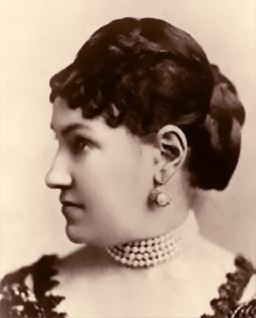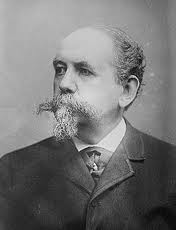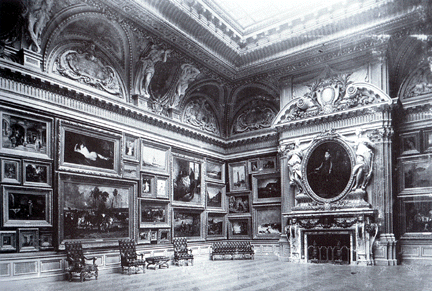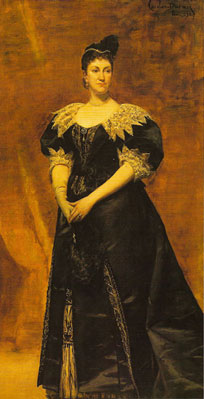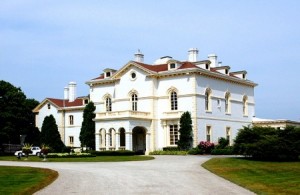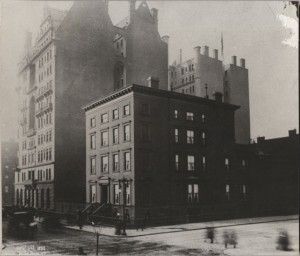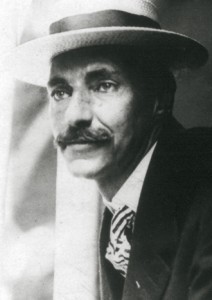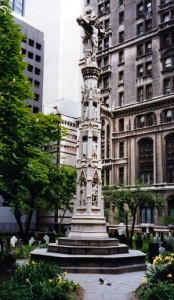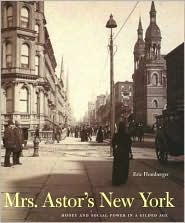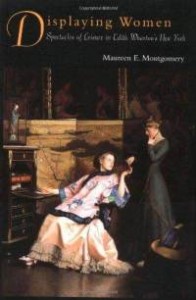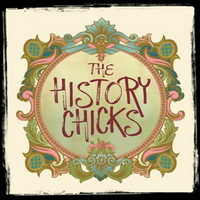Caroline, who was often called Lina, was born in September 22, 1830 to a very prominent wealthy family. She was the youngest of 10 children, and very much the family pet.
Her father Abraham was not only well thought of in New York business, but he and his wife, Helen White Schermerhorn, were established in high society when Lina was born.
Caroline was, naturally, raised in that New York society. She enjoyed the life a life of privilege- doted on by nannies, servants, and tutors. We talk about her early life, and what proper bred young ladies learned, and their lives in New York, and Paris. And how academics took a backseat…waaay in the back.
Can’t talk about Caroline without a chat about the Gilded Age! The rapid economic and population growth had creation of a whole lot of social conflict. This period of time is called the Gilded Age because it looks golden, but looks are deceiving. Mark Twain and his co-writer Charles Dudley Warner, get credit for labeling the period in his book: The Gilded Age, a Tale of Today.
Back to Caroline…we fill in the blanks, but once she is grown, and ready to marry, her parents look at the Astor family. Caroline marries William Backhouse Astor, Jr. She has her breeding, her upbringing, her family’s money and now her husband with his money. She is in the position she was raised for. Love shmove, who needs it?
What is a properly bred woman at this age to do? First, she has to have some babies to raise in the manner she was raised. Within 10 years she has five children—4 girls and a boy -and off goes the baby machine. For about 20 years she is taking care of home and social business, hanging with her peeps, and history doesn’t place her much of anywhere. Although we like to talk about what that life is like.
William spends much of his time…away. He is not all that active in family business. We talk on the podcast about what he WAS active doing. But, basically, he owns real estate all over the place and spends time in Florida working deals, and at the family estate, Ferncliff, in upstate NY, and on his yacht, the largest in the world, the Ambassadress (also called The Floating Harem).
Lina has the children almost raised, and the girls are ready to get paired off in marriage. She looks around and sees that the city is becoming a bulls-eye for new monied social climbers. Lina can’t have her New York Society over run by these people! They don’t appreciate the heritage! They flaunt their wealth! Oh, no, they are not our type dear. (This is the highly simplified, written History Chicks version. We go into some nifty stories on the podcast, especially one about A.T. Stewart.)
Enter Samuel Ward McAllister.
A southern gentleman who is, as his life’s work, basically a snob. He had been an attorney, raised in a fairly wealthy family, and traveled around Europe studying titled nobility. He is also an expert on wines and sauces. Yes, sauces. Think what you will, we did.
His wife was fairly wealthy, and pretty much out of the picture. William was out doing who knows what, so Caroline needed an escort for all the many social functions that she had on her plate. Since Ward wasn’t doing anything industrious at the time, except being obsessed with society and becoming prominent in it, he becomes her eminence grise ( look it up). Or she becomes his. We never are sure. Although that doesn’t stop us from speculating!
An idea is born to solve what Ward and Caroline see as a problem: defining who is in and out of society. The 400 and the Patriarchs Balls.
25 New Yorkers (The Patriarchs)would give several balls each season at Delmonico’s restaurant. Each of the 25 would be responsible for inviting 4 ladies and 5 gentlemen. The goal was to define society by and within this group. If you were invited to the balls, you were in. If not, you better go hide out for the night.
Who decided on the 25? Ward and a couple of his guy pals. They could ignore the new money, give a slight hand to slightly less new money, and totally fill the list with people they deemed fit for society—the older monied, of course. The 25 did grow to 50 over the years, with the addition of some newer money, the theory was that this tier would do their darndest to keep out upstarts who wanted in.
How did you get in? Anyone who made their wealth via a trade was out; if you had three generations in New York you stood a chance. If you were flashy with your cashy- out. If you had a box at the opera, maybe in. Calling card etiquette alone was daunting- these people had rules and if you didn’t follow them? Out.
Brilliant way to form a clique, non?
(The painting above the fireplace is of herself; the nude dominating the wall to the left is NOT her, but is Jules Lefebvre’s “Odalisque”. )
How did they get the name The 400? We bust a myth, and settle on one: Ward said there are only about 400 people in New York who are comfortable in a ballroom. He wasn’t far off – the lists numbered in the upper 300’s.
Of course, we talk about what went on at these affairs, the activities, the menus, THE CLOTHES! We could talk for a full episode about Worth gowns alone!
But we also tell you about a super amazing historical project that YOU can get involved in through the New York Public Library–even if you live far, far away from New York, like Kansas City! Imagine!
The 400 thing works for a while. Caroline is holding court on her velvet divan set up in her ballroom. She and Ward are dictating what is proper in society, making sure the rules are followed. The plan works not only in New York in the winter society season, but also in Newport in the summers. Caroline has a mighty impressive cottage in Newport called Beechwood. Yes, we talk about Newport! How can we not?
For about 10 years this system is in play. One family that has been snubbed is the Vanderbilts. I know, right? THE Vanderbilts! But they were not deemed worthy by Lina and Ward, regardless of the amount of cash they had. She felt them not ladies and gentlemen. Out.
Well, that is the extremly short, not exactly accurate version. The longer one admits that Astors attended a Vanderbilt wedding. That there were Vanderbilts invited to Patriarch balls. That the Vanderbilts were in society—but just not deep enough for one certain woman who takes off her gloves and throws down the gauntlet to represent the arrivistes, the people just trying to enter society: Alva Vanderbilt.
Topping the 400!: A Movie
Starring: Alva Vanderbilt, and her multi-million-dollar tricked out French chateau mansion in NYC, and invitations for all to a super swank mansionwarming party. Invitations to all, that is, except the William B. Astors.
Co-starring: Carrie Astor- deb daughter of Caroline who wants to attend THE fancy dress ball party of the season at the Vanderbilt’s new mansion. “But Mother! I don’t care if you have not paid a call to Mrs Vanderbilt! Do it! I have a dance all planned! Mother!”
Featuring: Mrs Astor’s calling card: which appears just before the ball, acknowledging the Vanderbilts as welcomed into society.
This event really is the beginning of the end of society as Mrs. Astor and Ward McAllister saw it. She keeps throwing her balls and dinners in NYC and Newport, but it’s not the same any longer. Not as elite as in her heyday.
(fade to black)
Bring back the lights! There are still some dramatic twists in Caroline’s life!
How did she become “The” Mrs. Astor? Simple, drop the “William” from her title of Mrs. William Astor. There are other contenders for the title, most notably her nephews wife, BUT Caroline feels entitled to the title and she takes it. And people listen. A great deal of this is played out in the press, who make it a bigger deal than it really was, but it makes for a great story, don’t you think?
How did they all fare later in life? Of course we go into a bit more detail on the podcast but basically:
William B. Astor dies of an aneurism in Paris. Sad.
William’s brother, John Jacob Astor III, dies and leaves his wealth to his first-born son- William Waldorf Astor, who rips down Dad’s house and builds a hotel- The Waldorf. This William Astor was living in England, a move we will talk about in another podcast- but the two sides of the family never got along so well. He wants to physically trump his Aunt Caroline by building this massive structure right next door. She, eventually, rips down her own house and builds another hotel, The Astoria. Eventually the two hotels merge, via a walkway called Peacock Alley, to become the Waldorf-Astoria. That gets ripped down as well, moves to another part of the city (at least, the name does, though strangers now owned it) and in its place is now the Empire State Building.
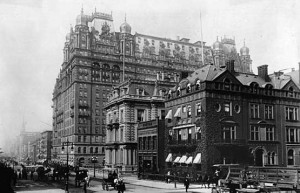
What the hotel finally looked like, all put together. Note AT Stewart’s “hideous” house just across the street.
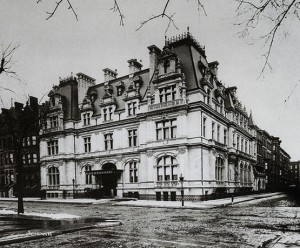
Her final house – shared with her son. Hmmm. Looks like the Stewarts were just ahead of their time. This looks familiar!
Ward? Quite full of himself he writes a tell-all entitled , Society As I Have Found It. Uh, not well received by society- they are not keen on publicity, Lina and Ward taught them that–he pretty much gets shunned and dies alone.
Alva? Having achieved her goal of entering society becomes a head of it in both NY and Newport. She divorces William K, marries another gentleman of society, Oliver Belmont. She puts her energy to other interests including becoming a suffragist and marrying off her daughter Consuelo… but that is a whole other tale of this fascinating Gilded Age that we will tell next time.
And Caroline? She kinda goes crazy with dementia, has a heart ailment, and a stroke. She leaves society – although not in her head. She still lives as if she is entertaining for many years-and dies in 1908 at the age of 78.
Four years later, the Titanic goes down, taking her only son- John Jacob Astor, IV with it.
Her body is entered in the Astor family vault, but a cenotaph is erected in her honor to memorialize her.
Time Travel with The History Chicks
You can’t tour Caroline’s mansion in real life, but this blog has a fun pictoral tour of her summer home, Beechwood, taken when the estate was a living history museum. http://www.galenfrysinger.com/newport_beechwood.htm
There are some Newport, RI mansions that you CAN—we recommend The Elms—but check all of them out here. Be sure to book the “back stairs tour” ahead of time – space is very limited! http://www.newportmansions.org/index.cfm
This blog is devoted to Gilded age archetecture… Pictures and floorplans a plenty! This link will take you to the floorplans of the mansion that she shared with her son, but play around on the site. http://garylawrance.blogspot.com/2010/03/mrs-astors-mansion.html
We hope we sold you on clicking over to the New York Public Library and assisting with transcribing history via their amazing menu collection! Go do your part, it’s easy and very interesting! http://menus.nypl.org/
If you are hankering for some more New York history, no one does it better than fellow podcasters, The Bowery Boys. Surely you know them! Go listen, absorb. Podcasts on itunes- these guys have been at it for awhile so there is an archived listing , as well as a current one. Or check them out here: http://theboweryboys.blogspot.com/
The New York Times has archived society columns discussing Patriarchs Balls and other events…you could spend a great deal of time reading these: http://query.nytimes.com/gst/abstract.html?res=F40B14F6395B10738DDDA90B94DA415B8584F0D3
Want to follow current New York Society? Check out this site :http://www.newyorksocialdiary.com/
You want the 411 about Late Victorian Fashion? So do we: http://www.fashion-era.com/mid-late_victorian_fashion.htm
Like your books?
Beckett recommended this one:
And
And finally, Ward McAllister’s Society As I Have Found It, read it online – http://openlibrary.org/books/OL6599583M/Societyas_I_have_found_it.
As always, music for our podcast comes courtesy of Music Alley. Visit them at music.mevio.com.

